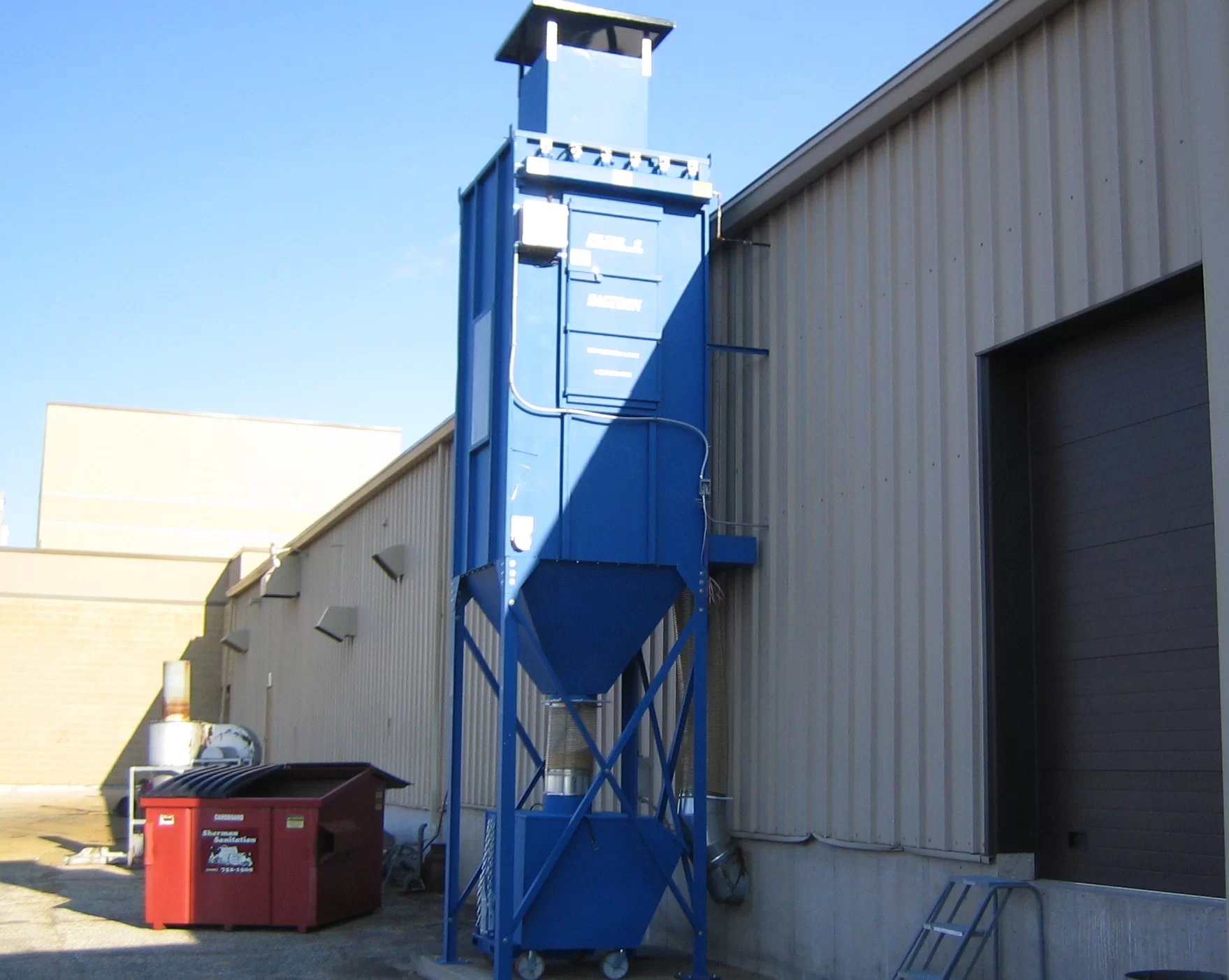Bag House Dust Collector
Home / Products / Dust Collector Manufacturers/ Bag House Dust Collector
Bag House Dust Collector Manufacturer
A baghouse dust collector, also known as a fabric filter dust collector, is a type of air pollution control device used to capture and filter particulate matter from industrial processes. Here’s an overview of baghouse dust collectors, including their features, working principle, applications, benefits, and considerations:
Working Principle
- Inlet: Dust-laden air enters the baghouse dust collector through an inlet duct or hood, where it is directed into the housing containing the filter bags.
- Filtration: As the air passes through the filter bags, dust particles are captured on the surface of the filter media, while the cleaned air passes through and exits the collector.
- Bag Cleaning: Periodically, the filter bags are cleaned to remove accumulated dust and maintain optimal filtration efficiency. This is typically achieved using a pulse-jet cleaning system, where compressed air pulses are directed into the bags to dislodge the dust.
- Collection: The dislodged dust falls into a collection hopper or bin located at the bottom of the dust collector, where it is collected for disposal or recycling.
- Outlet: The cleaned air exits the dust collector through an outlet duct or stack and is discharged back into the atmosphere or directed to additional filtration stages for further purification.

Bag House Dust Collector Manufacturer
Features of Bag House Dust Collector
- Filter Bags: Baghouse dust collectors contain numerous fabric filter bags made of various materials such as woven or felted fabrics, fiberglass, or synthetic fibers. These filter bags act as the primary filtration medium for capturing dust particles.
- Modular Design: They often have a modular design, allowing for easy installation, maintenance, and expansion as needed to accommodate changes in production or process requirements.
- Multiple Compartments: Many baghouse dust collectors consist of multiple compartments or sections, each containing a set of filter bags. This compartmentalized design allows for efficient dust collection and filtration while optimizing airflow and pressure drop.
- Pulse-Jet Cleaning System: Baghouse dust collectors typically utilize a pulse-jet cleaning system to clean the filter bags periodically. This system involves injecting short bursts of compressed air into the filter bags to dislodge accumulated dust, which then falls into a collection hopper for disposal.
- High-Efficiency Filtration: Baghouse dust collectors offer high-efficiency filtration, capable of capturing a wide range of particulate matter sizes, from coarse dust particles to fine airborne contaminants.
- Variety of Configurations: They are available in various configurations, including reverse-air, shaker, and pulse-jet designs, to suit different application requirements and operating conditions.
- Durable Construction: Baghouse dust collectors are typically constructed of heavy-duty materials such as steel or stainless steel to withstand the harsh operating conditions encountered in industrial environments.
- Bag Cleaning Mechanisms: Depending on the design, baghouse dust collectors may incorporate different bag cleaning mechanisms such as mechanical shaking, reverse-air flow, or pulse-jet systems to ensure effective cleaning and maintenance of the filter bags.
Applications of Bag House Dust Collector
- Metalworking: Baghouse dust collectors are commonly used in metal fabrication and processing industries to capture metal dust, fumes, and particulates generated during cutting, grinding, welding, and machining operations.
- Woodworking: They are utilized in woodworking shops and sawmills to capture sawdust, wood chips, and other wood particles produced during cutting, sanding, planing, and shaping processes.
- Chemical Processing: Baghouse dust collectors are employed in chemical processing plants to capture hazardous dust, powders, and vapors generated during mixing, blending, drying, and packaging operations.
- Cement and Mining: They are used in cement manufacturing plants and mining operations to capture dust and particulates generated during material handling, crushing, grinding, and conveying processes.
- Food and Pharmaceutical: Baghouse dust collectors find applications in food processing and pharmaceutical manufacturing facilities to capture airborne dust, powders, and contaminants generated during mixing, grinding, and packaging operations.
Benefits of Bag House Dust Collector
- High-Efficiency Dust Collection: Baghouse dust collectors offer high-efficiency filtration, capable of capturing a wide range of particulate matter sizes, including fine dust particles and airborne contaminants.
- Improved Air Quality: By capturing and removing dust and particulate matter from industrial processes, baghouse dust collectors help improve indoor and outdoor air quality, reducing the risk of respiratory issues and environmental pollution.
- Compliance: They assist industrial facilities in complying with environmental regulations and emission standards governing air quality, particulate matter emissions, and workplace safety.
- Equipment Protection: Baghouse dust collectors help protect downstream equipment, machinery, and ductwork from dust buildup and contamination, minimizing maintenance costs and downtime.
- Versatility: They are suitable for a wide range of industrial applications and process conditions, offering flexibility and adaptability to various dust collection requirements.
- Energy Efficiency: Baghouse dust collectors can be equipped with energy-efficient features such as variable frequency drives (VFDs) and optimized airflow designs to minimize energy consumption and operating costs.
Considerations
- Filter Media Selection: Choosing the appropriate filter media material and configuration is crucial to ensure effective dust capture and filtration for specific dust types and process conditions.
- Filter Maintenance: Regular inspection, cleaning, and replacement of filter bags are essential to maintain optimal filtration efficiency and prevent pressure drop and airflow restrictions.
- System Design: Proper sizing, layout, and configuration of the baghouse dust collector system are critical to ensure adequate airflow, pressure drop, and dust collection efficiency for the specific application and operating conditions.
- Airflow Management: Balancing airflow distribution and pressure drop across the filter bags and compartments is essential to optimize dust collection performance and minimize energy consumption.
- Material Handling and Disposal: Proper handling and disposal of collected dust and particulate matter are necessary to prevent environmental contamination and comply with waste disposal regulations.
- Noise and Emissions: Consideration should be given to noise levels and emissions generated by the baghouse dust collector system, especially in noise-sensitive environments and areas with strict emission limits.
